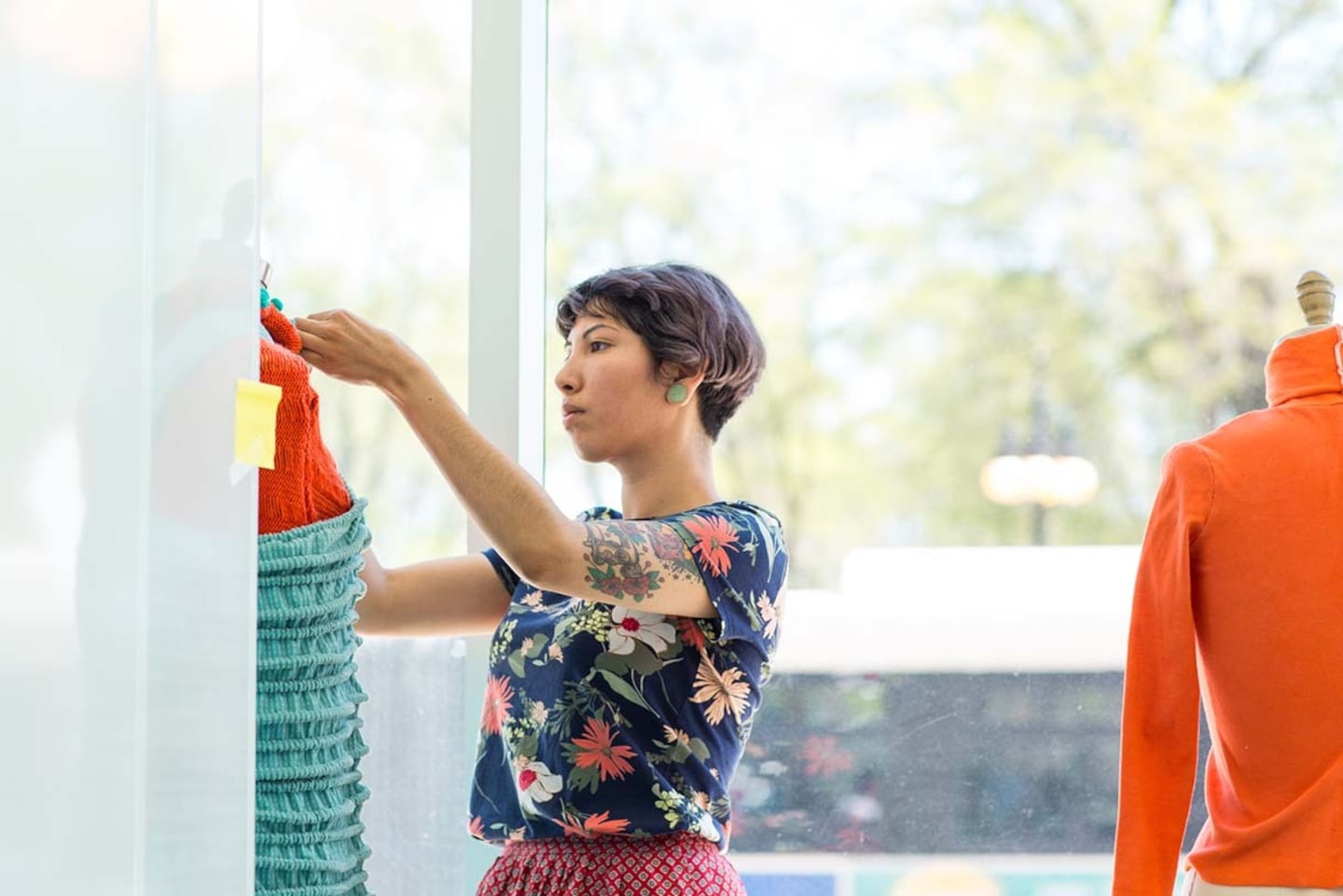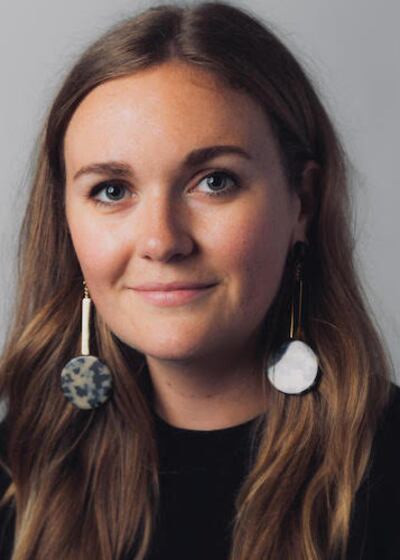
The Business of Fashion
Agenda-setting intelligence, analysis and advice for the global fashion community.

Agenda-setting intelligence, analysis and advice for the global fashion community.

Columbia College Chicago — a creative and liberal media arts college located in Downtown Chicago — designed its curriculum to give fashion students hands-on practice married with technological innovation and rooted in the diversity, equity and inclusion mission of their institution.
The college offers a BFA in fashion design and an BA in fashion studies with concentrations in either merchandising or product development. The merchandising concentration focuses on the business side of the industry, with courses in marketing, sales and buying, as well as pricing, inventory and supply chains; the product development specialty emphasises principles of design thinking and design anthropology, as well as technical skills for students to develop their own aesthetic within a commercial setting.
With the fashion department situated on Michigan Avenue, students are immersed in Chicago’s retail district and taught to analyse brand strategies on pricing, fabrics, design and visual merchandising using existing market strategies. Across the BFA and BA concentrations, students have the opportunity to utilise the fashion school’s street-facing window display just south of the famed Magnificent Mile. The windows leverage QR codes, a dedicated website and digital functionality that enable interactions with members of the public — allowing students to share more about their work and engage with the local community.
Columbia College Chicago offers further hands-on education through its extensive fashion archive, managed under collection director and professor Dr. Lauren Downing Peters, who works closely with students to teach curatorial exhibition practices. Accessible by all departments, students can work on multi-disciplinary projects utilising the archive with individuals studying other majors, from photography, graphic design, interior design, filmmaking and more.
Now, BoF sits down with faculty members from the fashion department to understand how the department implements applied and interactive educational projects to ground their students’ education.

Dr. Colbey Reid — Chair of Fashion Studies
As professor and chair of Fashion Studies, Reid specialises in the theory of style and its impact on contemporary consumer culture. She founded Columbia College’s Fashion Lab and has directed over 50 academic and industry research partnership projects.
What defines the college’s approach to education?
We try to create a curriculum tailored to what we’ve observed students respond to — how they learn, what excites them and what invigorates them. This very hands-on approach has emerged, focused on the students’ preferences for experiential learning.
We pair our design thinking courses with hands-on making and technological construction. We don’t see one as precluding the other — we see a more supportive relationship. For example, we have a faculty member who teaches embellishment and embroidery, and we have a version of the class taught by one of our faculty that focuses on neo technologies of embroidery and embellishment. The students then 3D print the ornaments that they use for embellishment.
What lessons will you retain from remote education?
We generated workshops that responded to conditions and concepts raised by the crisis. We did a workshop on accessible mask making in partnerships with fashion designers and sign language students, to make them accessible to deaf members of our communities. I loved having students engage in problem-solving from an interdisciplinary lens and focus on accessibility.
I want to retain a sense of higher education as a space in which to engage not only with the history of craft, practice and thought, but also with the present.
There is widespread belief that Gen-Z students prefer digital experiences but, in my experience, they still crave and long for ways to be face-to-face, engaging in material practices with each other and with our teaching staff. So, we are really focusing on experiential application.
In my experience, [students] still crave ways to be face-to-face, engaging in material practices with each other and our teaching staff.
How does the school’s location inform the educational experience?
Our students create exhibitions several times a year that have an external audience just by virtue of the fashion department’s location on Michigan Avenue and its shop window. It allows our students to think in a hands-on, material way about how to create an engaging story for a wide and diverse audience.
I see that window as being deeply connected to the diversity, equity and inclusion mission of our institution. We’re interested in how we can use these windows as a fluid space to break out of the walls that often exist between us and the city. It’s fundamental to our conceptualisation of how we practice fashion. Some of the exhibits are controversial and the response is positive, sometimes not. I love how much work those windows do to stimulate discourse in real-time.
Last spring, one of our classes created an exhibit featuring Black designers in our study collection and were invited onto the Chicago Morning Show to talk about their exhibit, conversations and thinking that led to their decision. We also engage in external partnerships. You might see an exhibit by the New York-based artist, Maria de Los Angeles, for example. She creates paper dresses hand-painted with the iconography and words telling the stories of undocumented immigrants.
How is the archive utilised by students?
Our archive is not a “don’t touch” archive — students and faculty use it to better understand fashion histories and to examine articles of dress. They approach the archive like fashion engineers and think about structure, form and design in varied ways. I see the archive as a jewel in the crown of our department — it’s an anthropological artefact of our culture.
Students know that they can draw from the archives to find themes that haven’t been seen before — that’s very empowering for them to know they can tell that story in a very public way using our window.

Dr. Lauren Downing Peters — Assistant Professor of Fashion Studies & Fashion Study Collection Director
Assistant professor and fashion study collection director, Peters is also the editor-in-chief of The Fashion Studies Journal; a co-founding member of The Fashion Studies Alliance; and the curator of the 6,000 piece archive, which includes pieces dating back to 1830.
How do you prepare students for working in the industry?
Our faculty and a lot of our adjuncts who are straddling academia and industry pride themselves on immersing our students in fashion as a dispersed practice. Students are placed into the field to meet those working and solving problems on the ground. Through our study abroad programmes, they can build up international networks as well.
In our visual merchandising classes, for example, students test different strategies and skills within our display cases, but also have the opportunity to put a window together at Macy’s. Our fashion lab is another opportunity for students to work with local and international industry partners to solve real-world problems that will go into action.
We also address cultural appropriation, sustainability and labour issues — some of the biggest existential crises facing the fashion industry. As difficult as those conversations are, we don’t shy away from them. We are giving students the tools and especially the language to be active agents in changing the fashion industry.
We are giving students the tools and especially the language to be active agents in changing the fashion industry.
How do you leverage the archive in your teaching?
I use it for all my classes. It’s especially useful in my fashion history class where students get to see and touch history. As the director of the collection, I also work with my colleagues to imagine how dress objects could be used within other fashion courses and humanities classes. We try to make it open and accessible.
It’s been a wonderful, community-building tool and the students have embraced the opportunity to work with hands-on objects.
What is an example of how you work with the local community?
My practicum, “Fashion and Dress Beyond the West,” takes what students have learnt in visual merchandising and graphic design, and enables industry application to test their skills, in addition to exploring them in a context that is not typically explored within an undergraduate educational framework.
We partner with local artists and fashion designers to show their work, we use the windows to show this, which can include design work as well as projects put together from our fashion archive.
Through this, the students are exposed to fashion curating as well opportunities to move into museum practice. This can be used for portfolios while creating something substantial and thoughtful for the Chicago community.

Raj Patel — Columbia College Chicago Graduate
Having graduated from Columbia College Chicago in 2021 with a BA in Fine Arts and Fashion Apparel Design, Raj Patel developed two window displays — in both his junior and senior year — around themes of animal extinction and the issues the world faced in 2021, from Covid-19 and police brutality to extreme weather due to the climate crisis.
What was your first impression of Columbia College Chicago?
I’m from India, so when I came here, the first thing I saw was the window display and I thought, “Wow, I want to display my work over here.”
In my senior year, I created 10 garments based on the pandemic, racism, police brutality, wildfires and child marriage. I got that privilege to display my senior thesis. It was a dream come true. Working on the window display gave me confidence to show my collection and experience criticism. It also taught me time management skills, as you have to prepare the window display in one day.
As an international student, I also had to find a job on campus. That job was actually helping artists to set up their window displays on 618 South Michigan Avenue.
Working on the display gave me confidence to show my collection and experience criticism.
How was technology integrated into your learning experiences?
There is access to technical software, such as Adobe Photoshop, provided by Columbia, in addition to laser cutting, 3D printing and digital pattern making — which I was able to use to create my collection. That was helpful to take it to the next level. I printed pictures of my work using the digital print centre, also a service provided by Columbia. Then, in my embroidery class, I created QR codes so that people could view my social media to discover the story behind my window display and feel more connected.
How much opportunity was there for interdisciplinary collaboration?
I worked with the photography department and with a group called Picture Perfect, for students who are interested in modelling. They contacted me asking to collaborate, so I did two fashion shows with them. After two years, I became creative director of that group. As an international student, it was hard for me at the beginning because I didn’t have many friends. But when I collaborated with photography students and modelling groups, it was fantastic.
I also had the pleasure of working with Dr. Lauren Downing Peters in the archive. As a fashion major, that room is heaven. It’s all vintage clothes, jewellery, shoes and hats. I had access for a whole week. I studied each and every fabric.
This is a sponsored feature paid for by Columbia College Chicago as part of a BoF Education partnership. To learn more about Columbia College Chicago, please click here.
From analysis of the global fashion and beauty industries to career and personal advice, BoF’s founder and CEO, Imran Amed, will be answering your questions on Sunday, February 18, 2024 during London Fashion Week.
The State of Fashion 2024 breaks down the 10 themes that will define the industry in the year ahead.
Imran Amed reviews the most important fashion stories of the year and shares his predictions on what this means for the industry in 2024.
After three days of inspiring talks, guests closed out BoF’s gathering for big thinkers with a black tie gala followed by an intimate performance from Rita Ora — guest starring Billy Porter.